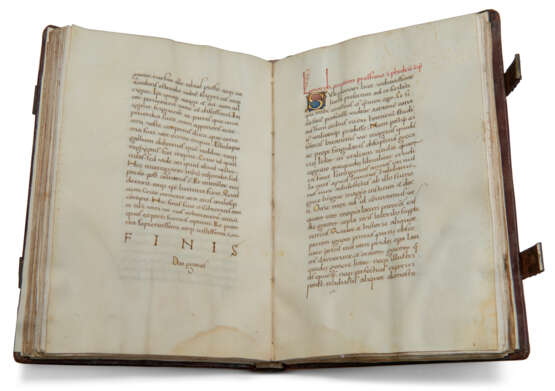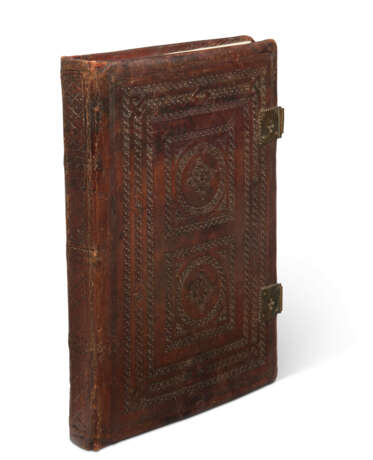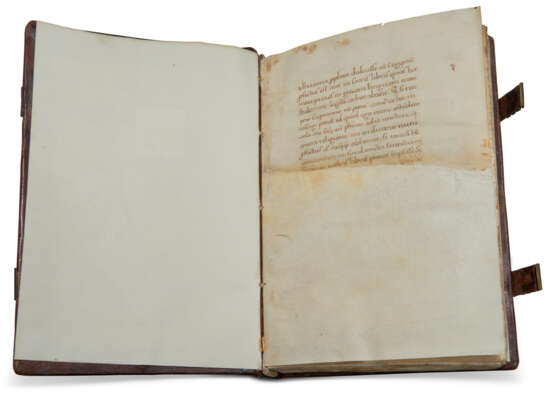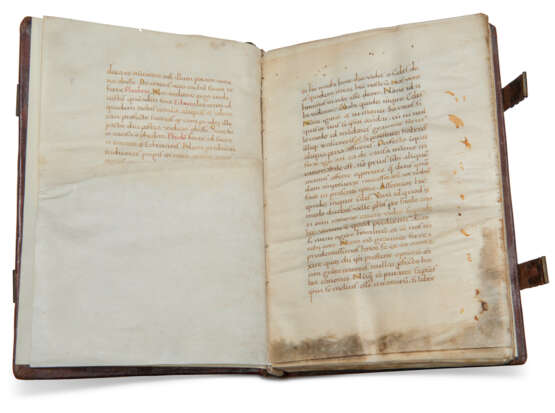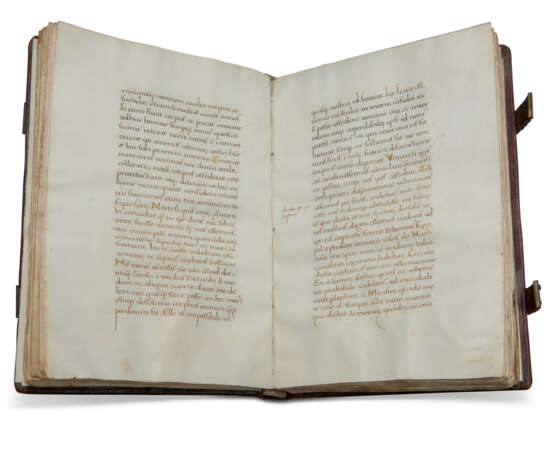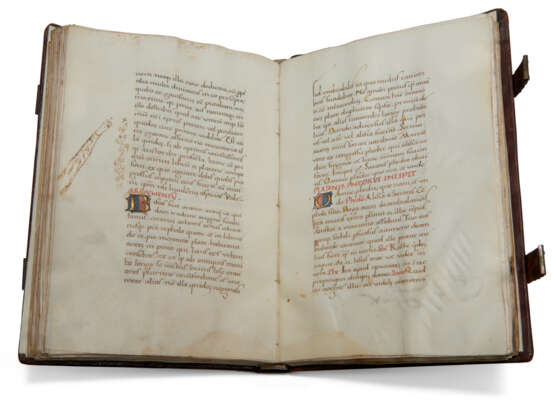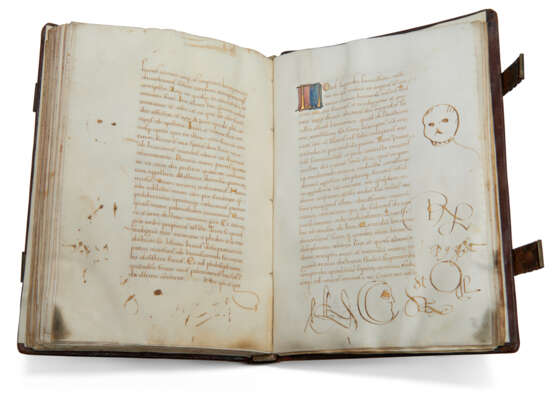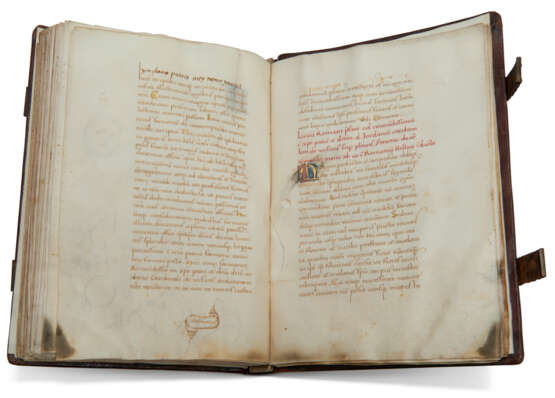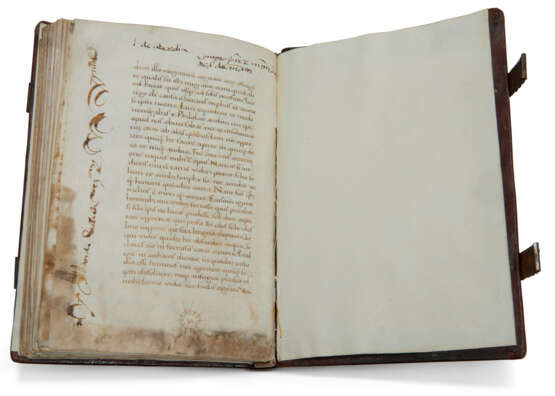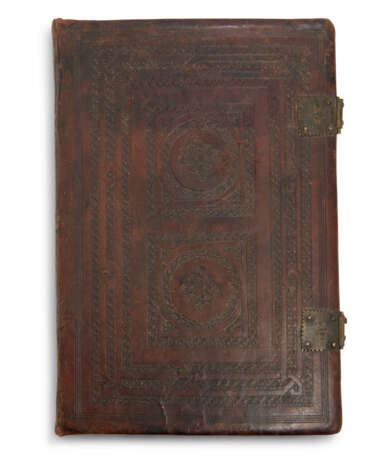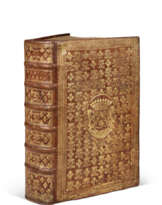ID 1214849
Los 41 | Plato (c.427-347 BC)
Schätzwert
£ 50 000 – 80 000
Phaedo and Phaedrus, in the Latin translation of Leonardo Bruni, and the Pseudo-Platonic Axiochus, trans. Cencio de' Rustici, illuminated manuscript on vellum [Italy or Spain, 2nd half 15th century]
The introduction of Plato to Renaissance Europe: three Latin translations of the Dialogues by the superlatively influential early Renaissance humanist Leonardo Bruni and his associate Cencio de’Rustici in a fine early 16th-century Spanish binding. Fifteenth-century manuscripts of Plato are rare at international auction: the Phaedo has appeared on only one other occasion, while no copies of the Phaedrus or Axiochus have appeared (RBH).
207 x 145mm. i (modern paper) + 87 leaves + i (modern paper), lacking leaves at each end and single leaves after ff.79 and 86, collation: 11 (incomplete; the final leaf of a gathering), 2-108, 11-127 (of 8, both lacking vii), catchwords in decorative cartouches, 25 lines, ruled space: 137 x 75mm, prickings survive, written in dark brown in a humanist minuscule, headings and names of the interlocutors in red, capitals touched in yellow, five illuminated initials on red and blue grounds, occasional contemporary marginalia in Latin, later marginal annotations in Spanish and doodles particularly towards the end of the manuscript and on the endleaves (first leaf significantly defective, presumably following the removal of an opening initial, marginal staining, most pronounced to ff.2-7 and 77-87).
Binding:
Early 16th-century Spanish blindstamped goatskin over thin wooden boards, sides framed with 3 interlaced borders of ropework tools, central compartments comprising 2 squares enclosing crosses of a different ropework tool, spine flat with hatched decoration, remains of original pierced metal catches on upper cover (rebacked, re-sewn); modern box.
Provenance:
(1) The manuscript was copied and decorated in 15th-century Italy or perhaps Spain: the binding, although not strictly contemporary, is Spanish, likely dating to the early 16th century, and the post-medieval marginalia is also Spanish. While surviving Latin manuscripts of Plato are generally of Italian provenance, the princes and clerics of Castile, Aragon and Portugal took an early interest in Italian humanism and works of the Florentine school circulated at the courts of the Iberian Peninsula and Aragonese empire, with manuscripts recorded in the possession of the historian Alfonso de Cartagena, the Spanish humanist Antonio de Nebrija and the Aragonese kings of Naples (J. Hankins, Plato in the Italian Renaissance, 1990, vol. I, pp.96-97); A. C. de la Mare suggests that a mid-15th-century manuscript containing the Phaedo (Marston MS 78, Beinecke Rare Book & Manuscript Library, Yale) may have been produced in Florence for Alfonso V, King of Aragon and Naples. Furthermore, Castilian translations of the Phaedo and Axiochus produced by Pero Díaz de Toledo in 1455 and c.1444 found an audience in the Spanish nobility with a limited knowledge of Latin, alongside contemporary translations of Virgil, Ovid and Seneca.
(2) Sotheby’s, 10 December 1996, lot 59.
(3) Schøyen Collection, MS 2336.
Content:
Plato, Phaedo, in the Latin translation of Leonardo Bruni (1369-1444), ff.1-61v, opening towards the end of Bruni’s prefatory letter to Innocent VII (‘a Iheremia p[ro]pheta didicisse […]’) on f.1, with the Phaedo itself beginning imperfectly on f.1v (‘de eare nu[n]ciaret […]’) and with the explicit (‘Et preterea sapientissimi atque iustissimi. Finis.’); Plato, Phaedrus, in the Latin translation of Leonardo Bruni, ff.62-79v, opening with his prefatory letter to Antonio Lusco (‘Leonardi arretini preffatio in phedrum incipit’) and an argumentum (f.63v; ‘Bisias fuit orator antiquus […]’), with the Phaedrus proper opening on f.64 (‘Platonis Phedrus incipit, O amice phedre quo nam et unde […]’), the text closing imperfectly a few lines from the end ‘Hec ipsa et ego’; Pseudo-Plato, Axiochus, in the Latin translation of Cencio de' Rustici, ff.80-87, opening ‘Locus siquidem suavissime velli’ (Bertalot, Initia Humanistica Latina, II, i, 1990, no 11194), with the prefatory letter to Cardinal Giordano Orsini on f.81 (‘Magna profecto et acquisita […]’) and the Axiochus itself starting on f.82 (‘[C]um ex athenis decedere[m] ad sepulchror[um] locu[m]’) and ending imperfectly (‘nec facilis cognitu ver[um]’).
The Latin translations undertaken by humanists of the Florentine school introduced Plato to Renaissance culture of the 15th century. Leonardo Bruni (c.1370-1444) translated the Phaedo – the middle-period Platonic dialogue on the immortality of the soul with its famous account of the death of Socrates – in Florence c.1405 and later dedicated his work to Innocent VII, the first humanist pope of the Renaissance. He completed his Phaedrus around 1424, the translation passing over the scenes of homosexual romance in Plato’s multi-faceted dialogue and focusing instead on the depiction of poetry and human love as species of divine possession. The pseudo-Platonic Axiochus – still attributed to Plato in the 15th century – was translated into Latin by Cencio de’Rustici (c.1390-1445), a younger associate of Bruni in the papal chancellery and an important member of the humanist group there. His most successful work, which depicts Socrates’ delivery of a consolatio mortis to the dying Axiochus, was dedicated to the patron, book-collector and ecclesiastical statesman Cardinal Giordano Orsini and seems to have been completed c.1436/7, when Cencio was with the papal entourage in Bologna.
Bruni was the best-selling author – at least in manuscript – of the 15th century, and his Platonic translations were about as popular as his historical works (Hankins, ibid, pp.95-98). They survive in over 250 codices of the period, the majority of which are held in public institutions: his Phaedo appears in manuscripts at the Bodmer Foundation (Cod. Bodmer 137, f.2v), the Vatican (cod.Vat.lat.3348, f.91, alongside Phaedrus, f.1; see Kristeller, Iter Italicum, II, 1967, p.360) and in the aforementioned copy at the Beinecke Library (Marston MS 78, f.1; paired with Bruni's translation of Xenophon's Hiero). Cencio’s Axiochus was also relatively well-known and is recorded in c.38 contemporary manuscripts (ibid). In spite of this, the three Platonic texts collected here rarely appear for public sale and the present combination – Phaedo, Phaedrus, Axiochus – may be uniquely represented together in a single 15th-century manuscript. Only one other Renaissance manuscript of the Phaedo has appeared at international auction, according to RBH (Bonhams New York, 1-10 June 2020, lot 10, a compilation of Platonic dialogues and other humanist texts on paper; a 1942 catalogue issued by Maggs Bros, London, briefly describes another manuscript on paper) and De Ricci lists only one copy in private hands in the United States (S. De Ricci, Census, I, 1935, p.1087, among only a handful of copies of any Platonic translation in any collection, public or private). The Phaedrus is recorded by de Ricci in only one manuscript, held at the Folger Library (V.a.107), and he lists no copy of Axiochus at all; none appear in the auction records.
| Herkunftsort: | Italien, Europa, Spanien |
|---|---|
| Kategorie des Auktionshauses: | Handschriften des Mittelalters und der Renaissance, Bücher und Handschriften |
| Herkunftsort: | Italien, Europa, Spanien |
|---|---|
| Kategorie des Auktionshauses: | Handschriften des Mittelalters und der Renaissance, Bücher und Handschriften |
| Adresse der Versteigerung |
CHRISTIE'S 8 King Street, St. James's SW1Y 6QT London Vereinigtes Königreich | |
|---|---|---|
| Vorschau |
| |
| Telefon | +44 (0)20 7839 9060 | |
| Aufgeld | see on Website | |
| Nutzungsbedingungen | Nutzungsbedingungen |
